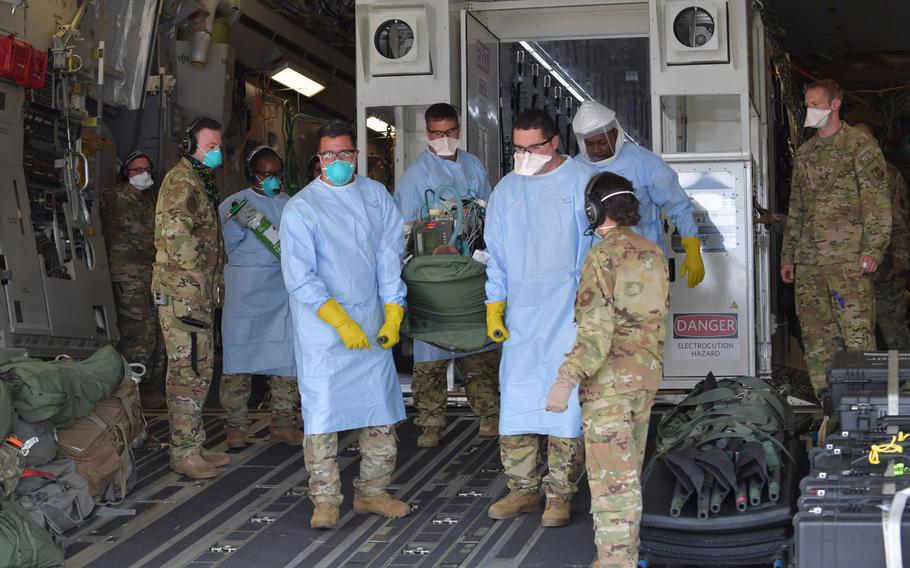
Airmen assigned to the 313th Expeditionary Operations Support Squadron transfer a coronavirus patient following the first operational use of the Negatively Pressurized Conex to transport 12 patients aboard a C-17 Globemaster III aircraft at Ramstein Air Base, Germany, July 1, 2020. (John R. Wright/U.S. Air Force)
Stars and Stripes is making stories on the coronavirus pandemic available free of charge. See other free reports here. Sign up for our daily coronavirus newsletter here. Please support our journalism with a subscription.
KAISERSLAUTERN, Germany — The Air Force more than tripled its capacity to transport coronavirus patients after customizing a steel shipping container for medical use aboard its cargo planes.
Twelve patients with the virus were evacuated on a C-17 Globemaster III from an undisclosed downrange location to Germany in what was the first operational use of the Negatively Pressurized Conex, a box configured to prevent spreading the disease to the crew, the service’s Air Mobility Command said in a statement.
The patients arrived at Ramstein Air Base on Wednesday after a 22-hour mission and were transported to Landstuhl Regional Medical Center for further care, officials said.
“This was definitely not your typical patient movement mission,” said Maj. Benjamin Weaver, a bioenvironmental engineer, in a statement.
Weaver, the 10th Expeditionary Aeromedical Evacuation Flight support team lead for the mission, said the container and team “performed exceptionally well to make it happen.”
The box can transport up to 28 seated passengers or eight litters. It can fit into a C-5 Super Galaxy or a C-17, while a smaller version can be used on a C-130 Hercules.
In April, the Air Force evacuated its first coronavirus patients, transporting three U.S. government contractors from Afghanistan to Ramstein. The patients were moved inside the Transport Isolation System, an infectious disease chamber developed but never used during the 2014 Ebola crisis.
That system has limited capacity — a C-17 can carry two of the airlocked units, each of which can carry only two to four patients.
The negative-pressure system was rapidly developed because of the pandemic, Air Force officials said.
Fans continuously pull air from within the unit through high-efficiency particulate filters, the Air Force said. The process is similar to hospital isolation rooms that use negative air pressure to prevent airborne diseases from escaping the room and infecting others.
The steel container also includes an attached anteroom — also under negative pressure — where medical workers can change clothes without risking contamination, the Air Force said.
This week’s mission brings the total number of patients transported in isolation containment chambers to more than 100 across 18 missions since the pandemic began, the Air Force said.
svan.jennifer@stripes.com Twitter: @stripesktown